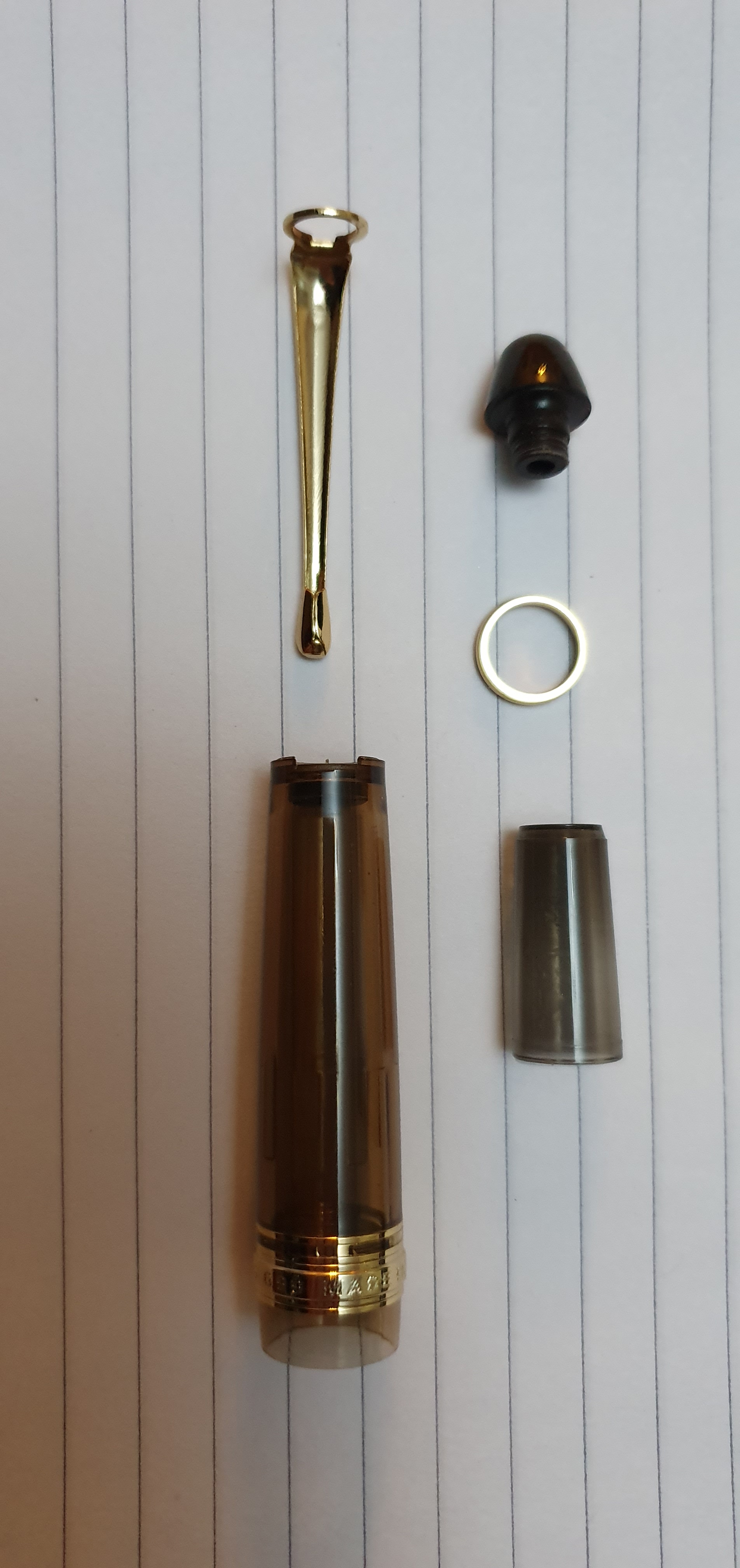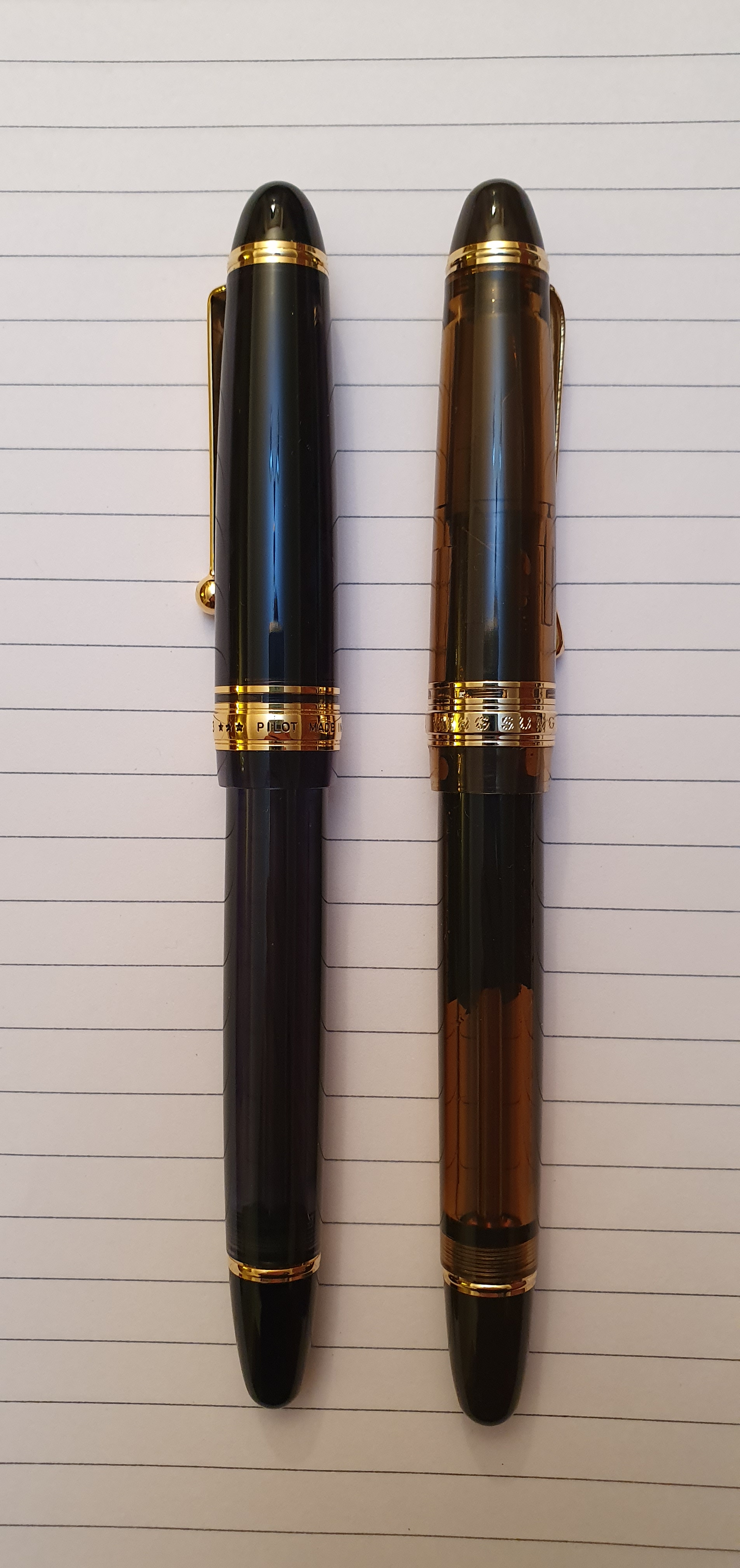As another year draws to a close, it is an opportunity to take stock on where the fountain pen hobby has taken me and what has been achieved over the year. Once again, the hobby has provided me with a real, absorbing source of relaxation. I spend a lot of my free time in journaling, letter writing, trying out pens, ink and paper combinations, and other pen-related activities.
Acquisitions.
Again, I have kept a record of pens added to my accumulation. This year there were 44 new arrivals. Of these, seven were received as gifts (including a Sailor Pro Gear Slim that I won in a competition!) which leaves a balance of 37 pens that I bought for myself over the year at a total cost of £2,013.91. However a lot of these were inexpensive pens, such as Faber Castell Grips, Kaweco Perkeos and Cross Bailey Lights, that I was unable to resist for various reasons.
If I just extract those pens for which I spent more than £100.00, there are in fact only six significant buys:
- Montblanc Meisterstuck 145, Classique, 14k gold nib Medium: £414.00;
- Leonardo Furore, steel nib, Fine: £155.00
- Diplomat Excellence Marrakech, 14k gold nib, Fine: £150.00;
- Waterman Carene, in red, 18k gold nib, Medium, £151.20;
- Visconti Van Gogh, Starry Night, steel nib, Fine: £120.00;
- Aurora 88, black resin with gold plated cap, 14k gold nib, Medium:£344.50.
I have not included the Montegrappa Monte Grappa, that I bought in Harrods but then returned.
Thus, two thirds of my annual spend was on just six significant pens, which is not a huge number for the whole year. Also, my total pen expenditure was down on 2018’s total of £3,303.73, which is a reduction of around 39%.
Part of the reason for this is that I was fortunate to be given several very desirable previously owned pens as gifts from a friend and fellow fountain pen enthusiast during the year, including a Pilot Custom 823, a Montblanc Heritage 1912, a 1970’s Montblanc Meisterstuck 146 (with a soft broad nib) and a Graf von Faber-Castell Guilloche in black with a broad 18k gold nib.
Then in November, I was thrilled to win the Sailor Pro Gear Slim, with a music nib in a generous giveaway/competition from John Hall of Write Here in Shrewsbury. This is a delightful pen, one that I had not owned before and which I am much enjoying, not only for its performance but also for the happy associations that it has for me.
Other highlights.
Apart from the enjoyment of new pens, the year has been punctuated with monthly gatherings of the London fountain pen club, although the group became fragmented with a move to a different location and so numbers have been down and it is not what it used to be. Still, it has still been nice to meet up, to enthuse over each other’s pens and have a chat for a couple of hours once a month.
In March, I attended the London Pen Show and came away with a very restrained total of two pens – the Diplomat Excellence with a gold nib and the Leonardo Furore, in vibrant orange and bearing serial number 001 for this colour.
I enjoyed taking a few pens on holidays for journaling during the year – to Dubai, Italy and Menorca. I have established a new tradition of bringing my Montblanc Classique as a travel pen for any overseas trips. Keeping an eye open for pen shops whilst abroad, is another of my habits.
In September the Pelikan Hub came round once again and was a rather expanded version of our pen club meets, but with a few extra visitors from further afield. We all got to take home a bottle of Pelikan Edelstein Star Ruby, a Pelikan magazine a writing pad and reignited our appreciation of all things Pelikan. Reading the write ups aftewards on social media, of Hubs all over the world was fun.
I have enjoyed putting out the occasional post to this blog, for another year. These are not planned very far in advance and depend upon (a) having something to say and (b) the time and energy to write it! This has not come together as much as I would have liked.
When the energy is not there, it is easier to relax and read other blogs and be inspired and entertained by posts on WordPress, Instagram and YouTube. It is all too easy to allow hours to pass in this way, which makes it all the more valuable to have some real human contact with the monthly pen meets.
I do appreciate the time and effort that others put in to creating new content for their blogs. I was sorry to see in November that Anthony had decided to call time on his blog, UK Fountain Pens after three prolific years but fully understood his reasons for doing so.
As for inks, I have not been very adventurous this year and have bought very little. My most used bottled inks are probably Conway Stewart Tavy, (a blue black now made by Diamine), Waterman Serenity Blue and Montblanc Royal Blue. At the pen show I bought a bottle of Montblanc William Shakespeare Velvet Red, which I have settled on for use exclusively with my Montblanc Classique.
I also discovered Montblanc Permanent Blue. I have been using this with a Platinum Procyon, as it has a good slip-and-seal inner cap that resists drying out. I have also put it in one of my Cross Bailey Lights.
I am impressed with the Permanent Blue. At Christmas my neice gave me an A5 soft cover journal, from “Agenzio by Paperchase.” As is my custom, I first tried out a range of different inks (from my currently inked pen cups) on the back page, to see which were best suited. The paper is pleasant to write on but is prone to bleedthrough with many of my inks. However I found that with Montblanc Permanent Blue, there was no bleedthrough and also hardly any show through, or ghosting. Likewise with Sailor Kiwa-guro permanent black and so these will be my choices for this note book.
Pen favourites of 2019.
I really have spoilt myself with pens this year and have had some great additions. I also count myself as very fortunate, among the pen community, to be capable of getting just as excited with an inexpensive pen if it is comfortable, well made and good looking and writes well, as an expensive one. But that is not to say that I do not appreciate great pens as having special value. A few of the stand-out pens for me in 2019 were the following:-
Montblanc Heritage 1912: this is the special edition, retractable nib, piston filling pen that came out a few years ago but is no longer made. It has a unique Montblanc nib that is softer than those on the current Meisterstuck range and is a pen to cherish and enjoy.

The Aurora 88: this was bought online from Iguanasell of Spain, when a particularly attractive price was available back in the summer. It is a piston filling pen, in black resin with gold plated cap and has a real presence. The 14k gold nib is supposedly a Medium but writes more like a Fine in my view and is very comfortable and enjoyable, paired currently with Tavy.

The Sailor Pro Gear Slim, with 14k music nib: The music nib provides a very pleasing italic line for general writing, when held at a consistent angle and when you keep it at the sweet spot. I think the “Slim” name is rather a misnomer and could be off-putting for some. The girth is not particularly slim, although it is smaller than the classic or the King of Pen, which are progressively larger. However it is a short pen at around 124mm capped, almost pocket-pen size, yet makes a very comfortable length when the cap is posted. This pen has won a special place in my heart.

The year’s best cheap pens.
I have enjoyed discovering plenty of very affordable and well-performing pens over the year. There is the Faber-Castell Grip, now sold in Paperchase at £15.00 with a smooth steel nib. In Dubai I came across a Pilot cartridge or eye-dropper pen called the AMS 86 G3 ASTD, sold on a blister pack for about £6.00 which was fun, although I made a mistake to start with in trying to force in the cartridge the wrong way round.
Towards the end of the year I was introduced to the new Cross Bailey Light, by Patrick, of John Lewis’ pen department. Over the following few weeks I went on to buy six of these, one in each of the available colours and now have them each inked in different inks. Patrick joked that he would have to send me on to the furniture department, to have somewhere to put all these pens.

Perhaps the greatest value though, has to be the Wing Sung 699, a vac filler and homage to the Pilot Custom 823 but with a steel nib and costing around £16 to £20 on ebay. I learned of these from Daniel at our pen club and now have two of them, one with a fine nib and one with a medium.

Conclusions.
Sitting down to write with a fountain pen, is one of life’s pleasures. Finding combinations of pen, ink and paper that go togther well, is part of the enjoyment. The act of “thinking with a pen”, remembering, reflecting and organising your thoughts on pen and paper is immensely satisfying.
I now find myself owning a large selection of excellent pens in a wide variety of brands and at all price levels up to around £400.00. I do not have a strong desire to go above that ceiling, although if I did, the ones that tempt me are the Scribo 3 , Pelikan M1000 or the Montblanc 149. At a lower level, I could easily be tempted to try other pens and nibs from Sailor, perhaps a Pro Gear Classic or a 1911 Large. If I can stop myself from buying quite so many pens next year, I could aim for a select few special pens and still come under my total spend figure for this year.
For all this talk of pens, the hobby would be rather shallow but for the people who make up the fountain pen community of enthusiasts, users, collectors, reviewers, bloggers and Instagrammers and YouTubers, plus the manufacturers, dealers, the friendly sales staff I have dealt with in shops over the year and those who run all the enticing sites such as Cult Pens, The Writing Desk, Iguanasell and the like. A big thank you to them too and for all who read and support this blog. I wish you a Happy New Year!


 Wing Sung 699 fountain pen.
Wing Sung 699 fountain pen.
 Bicolour steel nib in a Fine.
Bicolour steel nib in a Fine. Wing Sung 699 (right), alongside a Pilot Custom 823.
Wing Sung 699 (right), alongside a Pilot Custom 823. Nib and feed.
Nib and feed.
 A lovely specimen and unbelievably great value.
A lovely specimen and unbelievably great value.



